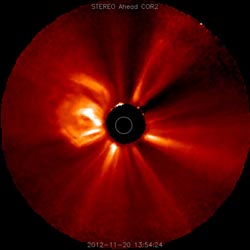NASA Spacecraft Observe Nov. 20 Solar Eruption

NASA's Solar Terrestrial Relations Observatory (STEREO) captured this image of a coronal mass ejection on Nov. 20, 2012 at 8:54 a.m. EST, about two hours after it left the sun. Credit: NASA/STEREO<br>
Experimental NASA research models, based on observations from the Solar Terrestrial Relations Observatory (STEREO), show that the Nov. 20 CME left the sun at speeds of 450 miles per second, which is a slow to average speed for CMEs.
CMEs can cause a space weather phenomenon called a geomagnetic storm, which occurs when CMEs successfully connect up with the outside of the Earth's magnetic envelope, the magnetosphere, for an extended period of time.
In the past, CMEs of this speed have not usually caused substantial geomagnetic storms. They have caused auroras near the poles but are unlikely to cause disruptions to electrical systems on Earth or interfere with GPS or satellite-based communications systems.
NOAA's Space Weather Prediction Center (http://swpc.noaa.gov) is the United States government's official source for space weather forecasts.
What is a CME?
For answers to this and other space weather questions, please visit the Spaceweather Frequently Asked Questions page:
http://www.nasa.gov/mission_pages/sunearth/spaceweather/index.html
Karen C. Fox
NASA's Goddard Space Flight Center, Greenbelt, Md.
Media Contact
All latest news from the category: Physics and Astronomy
This area deals with the fundamental laws and building blocks of nature and how they interact, the properties and the behavior of matter, and research into space and time and their structures.
innovations-report provides in-depth reports and articles on subjects such as astrophysics, laser technologies, nuclear, quantum, particle and solid-state physics, nanotechnologies, planetary research and findings (Mars, Venus) and developments related to the Hubble Telescope.
Newest articles

Superradiant atoms could push the boundaries of how precisely time can be measured
Superradiant atoms can help us measure time more precisely than ever. In a new study, researchers from the University of Copenhagen present a new method for measuring the time interval,…

Ion thermoelectric conversion devices for near room temperature
The electrode sheet of the thermoelectric device consists of ionic hydrogel, which is sandwiched between the electrodes to form, and the Prussian blue on the electrode undergoes a redox reaction…

Zap Energy achieves 37-million-degree temperatures in a compact device
New publication reports record electron temperatures for a small-scale, sheared-flow-stabilized Z-pinch fusion device. In the nine decades since humans first produced fusion reactions, only a few fusion technologies have demonstrated…





















